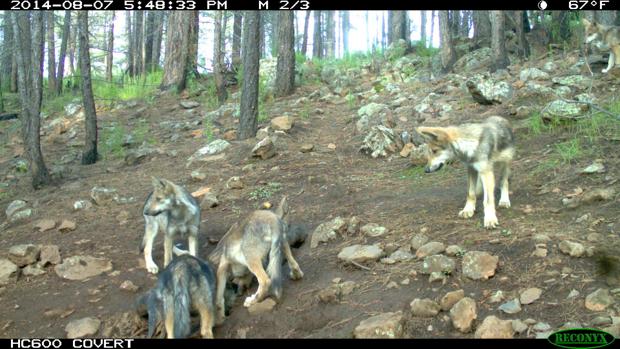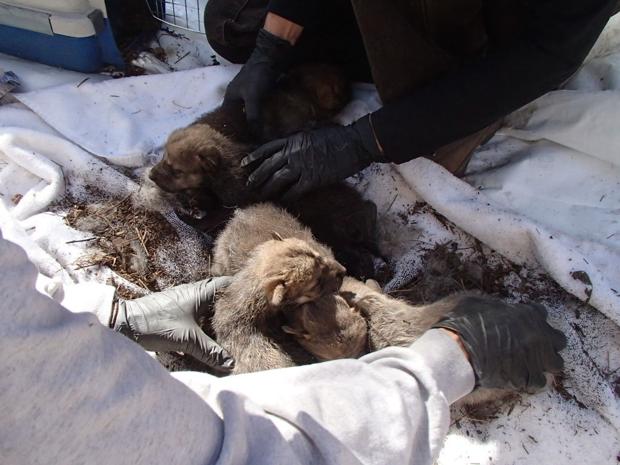
It was around this time a year ago
when state and federal biologists ventured into the Apache Sitgreaves
National Forests, crept into the den of a female Mexican gray wolf who
was briefly being held in a crate and whisked her six pups away.
The robbery of sorts was for a good cause: two of the pups (the other four were later returned to their mother) were going to be transferred to the den of a wild Mexican wolf pack in New Mexico’s Gila National Forest as part of an experimental process called cross-fostering. Never tried before on the endangered Mexican gray wolf, the tactic has been a key tool for other species’ recovery by infusing wild populations with genetically diverse animals that were born in captivity.
The Arizona pups, whose mother had been bred in captivity, were brought to the den of a wild female wolf that had recently given birth to three pups of her own. When they brought in the newcomers, biologists rubbed them in the dirt of the den and rubbed the bellies of the three original siblings to get them to urinate on the new arrivals so they all smelled the same.
Then the humans placed the tiny animals, weighing one to two pounds each, in a huddle before the mother arrived home. Part of the reason why the process works is because wolves can’t count, making it harder for them to distinguish between adopted pups and their own.
A year later, one of the cross-fostered wolf pups has been tracked via a radio collar and officials say they believe the other is alive as well. But while state wildlife managers have called cross-fostering a success and a promising tool for the future, many people acknowledge it’s also a tricky, delicate process that likely won’t be enough to form the foundation of the species’ recovery.
“Cross-fostering is a tactic, not a plan,” said Richard Fredrickson, a Montana-based biologist who has been on the Mexican Wolf Recovery Team since 2011. “In my opinion it’s very unlikely to really address the problem (of species recovery).”
State wildlife officials and wolf advocates agree that maintaining genetic diversity, which is key to establishing a stable population that can adapt to changing environmental factors, can’t happen without human intervention.
Cross-fostering is "one of most valuable tools we have in managing genetic diversity,” said Jim deVos, assistant director for wildlife management with the Arizona Game and Fish Department.
The process infuses different genes into the wild population by allowing biologists to hand-pick pups that are the most genetically distinct. It’s also preferable to releasing captive adults into the wild, because those animals tend to have a higher rate of encounters with livestock and humans, deVos said.
What makes the cross-fostering process so difficult, though, is the fact that it depends on luck. For the process to work, pups from the two litters, one captive and one wild, have to be born within five days of each other and the switch has to be done within the first 10 to 14 days of the birth date, said Jeff Dolphin, Arizona Game and Fish Department's field supervisor for the Mexican wolf project.
Wildlife managers have to be closely monitoring the packs for any hope of catching that overlap and taking advantage of it for cross-fostering.
The window for potential cross-fosters this year lasted just 25 days, from April 15 to May 10, Dolphin said. Because the tactic has been used only once with the Mexican wolves, it’s also impossible to compare data on the success rate of cross-fostering versus releasing adult wolves from captivity, said Susan Dicks, a biologist and veterinarian who works with the U.S. Fish and Wildlife Service.
“I think that anything that is able to get more wolves into the wild is a good thing and any way that they can start increasing genetic diversity of the population in the wild is also a very good thing,” Renn said.

But she stressed that transferring genetically diverse adult wolves from captivity into the wild still is an important part of Mexican wolf recovery that isn’t happening at the rate it needs to be.
Between 1998 and 2014, 95 wolves born in captivity have been released into the wild, though only eight of those releases have happened since 2005.
Focusing on pups “shouldn't prevent continuing to release adult wolves that are more diverse genetically into the wild,” Renn said. She added that relying heavily on cross-fostering to increase the wild population of wolves is “a risky gamble,” she said.
Frederickson also criticized what he described as “inaction” by state and federal officials in the Mexican wolf reintroduction program, calling it the greatest threat to the species.
Government officials need to develop a plan with quantitative goals connected to reducing the degree of relatedness between the animals that has a short-term and long-term timeline, he said.
As for the Mexican wolf recovery plan that was supposed to accomplish some of those objectives, it was put on hold more than two years ago, said Jeff Humphrey, spokesman for the U.S. Fish and Wildlife Service. Humphrey estimated it will be another two to three years before that plan is finalized.
source
The robbery of sorts was for a good cause: two of the pups (the other four were later returned to their mother) were going to be transferred to the den of a wild Mexican wolf pack in New Mexico’s Gila National Forest as part of an experimental process called cross-fostering. Never tried before on the endangered Mexican gray wolf, the tactic has been a key tool for other species’ recovery by infusing wild populations with genetically diverse animals that were born in captivity.
The Arizona pups, whose mother had been bred in captivity, were brought to the den of a wild female wolf that had recently given birth to three pups of her own. When they brought in the newcomers, biologists rubbed them in the dirt of the den and rubbed the bellies of the three original siblings to get them to urinate on the new arrivals so they all smelled the same.
Then the humans placed the tiny animals, weighing one to two pounds each, in a huddle before the mother arrived home. Part of the reason why the process works is because wolves can’t count, making it harder for them to distinguish between adopted pups and their own.
A year later, one of the cross-fostered wolf pups has been tracked via a radio collar and officials say they believe the other is alive as well. But while state wildlife managers have called cross-fostering a success and a promising tool for the future, many people acknowledge it’s also a tricky, delicate process that likely won’t be enough to form the foundation of the species’ recovery.
“Cross-fostering is a tactic, not a plan,” said Richard Fredrickson, a Montana-based biologist who has been on the Mexican Wolf Recovery Team since 2011. “In my opinion it’s very unlikely to really address the problem (of species recovery).”
Diversity needed
The Mexican wolf is the rarest subspecies of gray wolf in North America, with a current population that descends from three lineages and just seven “founder” animals. Wildlife managers have counted at least 109 animals in the wild, but because the animals are so closely related, inbreeding accumulates quickly, Fredrickson said.State wildlife officials and wolf advocates agree that maintaining genetic diversity, which is key to establishing a stable population that can adapt to changing environmental factors, can’t happen without human intervention.
Cross-fostering is "one of most valuable tools we have in managing genetic diversity,” said Jim deVos, assistant director for wildlife management with the Arizona Game and Fish Department.
The process infuses different genes into the wild population by allowing biologists to hand-pick pups that are the most genetically distinct. It’s also preferable to releasing captive adults into the wild, because those animals tend to have a higher rate of encounters with livestock and humans, deVos said.
What makes the cross-fostering process so difficult, though, is the fact that it depends on luck. For the process to work, pups from the two litters, one captive and one wild, have to be born within five days of each other and the switch has to be done within the first 10 to 14 days of the birth date, said Jeff Dolphin, Arizona Game and Fish Department's field supervisor for the Mexican wolf project.
Wildlife managers have to be closely monitoring the packs for any hope of catching that overlap and taking advantage of it for cross-fostering.
The window for potential cross-fosters this year lasted just 25 days, from April 15 to May 10, Dolphin said. Because the tactic has been used only once with the Mexican wolves, it’s also impossible to compare data on the success rate of cross-fostering versus releasing adult wolves from captivity, said Susan Dicks, a biologist and veterinarian who works with the U.S. Fish and Wildlife Service.
Tactic, not a plan
Emily Renn, executive director of the Grand Canyon Wolf Recovery Project, agreed that cross-fostering is an important tool to promote the recovery of the species.“I think that anything that is able to get more wolves into the wild is a good thing and any way that they can start increasing genetic diversity of the population in the wild is also a very good thing,” Renn said.

State
and federal biologists cross-fostered Mexican wolf pups for the first
time last spring. The process, which aims to increase the endangered
wolf population's genetic diversity, involves transferring Mexican wolf
pups born in captivity to the den of a wild female wolf who also
recently birthed pups with the hopes that the wild mother will adopt the
new arrivals as her own. Photo courtesy of Arizona Game and Fish Department/ George Andrejko
But she stressed that transferring genetically diverse adult wolves from captivity into the wild still is an important part of Mexican wolf recovery that isn’t happening at the rate it needs to be.
Between 1998 and 2014, 95 wolves born in captivity have been released into the wild, though only eight of those releases have happened since 2005.
Focusing on pups “shouldn't prevent continuing to release adult wolves that are more diverse genetically into the wild,” Renn said. She added that relying heavily on cross-fostering to increase the wild population of wolves is “a risky gamble,” she said.
Frederickson also criticized what he described as “inaction” by state and federal officials in the Mexican wolf reintroduction program, calling it the greatest threat to the species.
Government officials need to develop a plan with quantitative goals connected to reducing the degree of relatedness between the animals that has a short-term and long-term timeline, he said.
As for the Mexican wolf recovery plan that was supposed to accomplish some of those objectives, it was put on hold more than two years ago, said Jeff Humphrey, spokesman for the U.S. Fish and Wildlife Service. Humphrey estimated it will be another two to three years before that plan is finalized.
source

